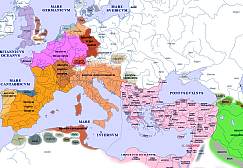

An Online Encyclopedia of Roman Emperors
Theodora (Second Wife of Justinian II )
Lynda Garland
University of New England, New South Wales Dethroned and mutilated in 695, the emperor Justinian II was exiled to Cherson on the Crimean peninsula. There he sought help from the Chazar chagan, the Chazar Turks being the ruling tribe in the northern Caucasus in this period. To cement the alliance Justinian married the chagan's sister in 703. The Chazar princess subsequently took the name of Theodora, which was doubtless intended by Justinian to recall the glories of the reign of the earlier imperial couple Justinian I and Theodora. The marriage of a member of the imperial family with the Chazar royal family was not a total departure from tradition: in 626 Heraclius had suggested his daughter, the Augusta Epiphania, as a wife for the Chazar commander Ziebel, while Constantine V was to marry a Chazar princess, whose name was perhaps Chichek, in 732.
While Justinian and Theodora were in exile at Cherson, Apsimaros, who as emperor took the name Tiberius, became aware of Justinian's plans to regain the empire and bribed Theodora's brother, the Chazar chagan, to deliver Justinian alive to him, or failing that his head. But Theodora was informed of the plot by one of her brother's servants. Her loyalties were now clearly with her new husband and his imperial plans rather than the country of her birth, despite the defects in Justinian's appearance (his nose and tongue had been amputated). She warned Justinian of the assassination attempt, and he eliminated those detailed to kill him, by inviting them singly to a private meeting and strangling them with a cord. After escaping, he sent Theodora back to Chazaria for safety. With the help of the Bulgar khan Tervel, he regained the throne in 705: Tervel's assistance was acquired by the promise in marriage of Justinian's daughter by his first wife Eudokia and many gifts, and he was given the title of Caesar on Justinian's restoration.[[1]]
Once safe in Constantinople Justinian sent to Chazaria for his wife and young son Tiberius, who had apparently been born in his absence. He appears to have expected opposition from his brother-in-law. A large fleet intended to escort them was sunk during a storm, which provoked a sarcastic message from the chagan: 'O fool, could you not have taken your wife on two or three ships without killing so great a multitude? Do you think that you are taking her, too, by war? Behold, a son has been born to you. Send your emissaries and take them away.' The cubicularius Theophylact was then dispatched to escort them safely to the capital.[[2]] On their arrival Justinian crowned both, Theodora as his Augusta and Tiberius as his co-emperor. Theodora was thus the first foreign-born empress of Byzantium.
Theodora's rule was to be short. The murder in 711 of her husband Justinian and her son Tiberius was to mean the end of the Heraclid dynasty. It is unclear whether Theodora was still alive at this point: according to the late source Zonaras, Theodora died before Justinian, perhaps because it was Anastasia, Tiberius' grandmother, and not Theodora, who was recorded as trying to save the young prince from being murdered like his father. But the fact that no tomb is recorded for Theodora suggests that she died after her husband and son and thus later than 711.[[3]] If she escaped imprisonment, or worse, in the capital, she presumably returned to her homeland.
Bibliography:
Nicephorus, Patriarch of Constantinople: Short History, ed. & tr. C. Mango, Washington DC, 1990.
Theophanes, Chronographia, trans. C. Mango & R. Scott, with G. Greatrex, The Chronicle of Theophanes Confessor: Byzantine and Near Eastern History AD 284-813, Oxford: Clarendon Press, 1997.
Dujchev, I. 'Le triomphe de l'empereur Justinien II en 705,' in Byzantion, Aphieroma ston Andrea N. Strato, Athens 1986, vol. I, 83-91.
Grierson, Philip 'The Tombs and Obits of the Byzantine Emperors (337-1042),' Dumbarton Oaks Papers 16 (1962) 1-63.
Haldon, J.F. Byzantium in the Seventh Century: the Transformation of a Culture, Cambridge University Press, 1990.
Head, C. Justinian II of Byzantium, Madison, Wisconsin, 1972.
Stratos, A.N. Byzantium in the Seventh Century, vol. 5, Amsterdam: Hakkert.
Sumner, G.V. 'Philippicus, Anastasius II and Theodosius III', Greek, Roman & Byzantine Studies, 17 (1976) 287-94.
Notes:
[[1]]Nicephorus 42; Theophanes AM 6196 [AD 703/4].
[[2]]Theophanes AM 6198 [AD 705/6]; Nicephorus 42.
[[3]]Zonaras 3.242; Theophanes AM 6203 [AD 710/11]; Nicephorus 45; Grierson 51.
Copyright (C) 2000, Lynda Garland. This file may be copied on the condition that the entire contents, including the header and this copyright notice, remain intact.
Comments to: Lynda Garland.
Updated:15 July 2000
For more detailed geographical information, please use the DIR/ORBAntique and Medieval Atlas below. Click on the appropriate part of the map below to access large area maps.
